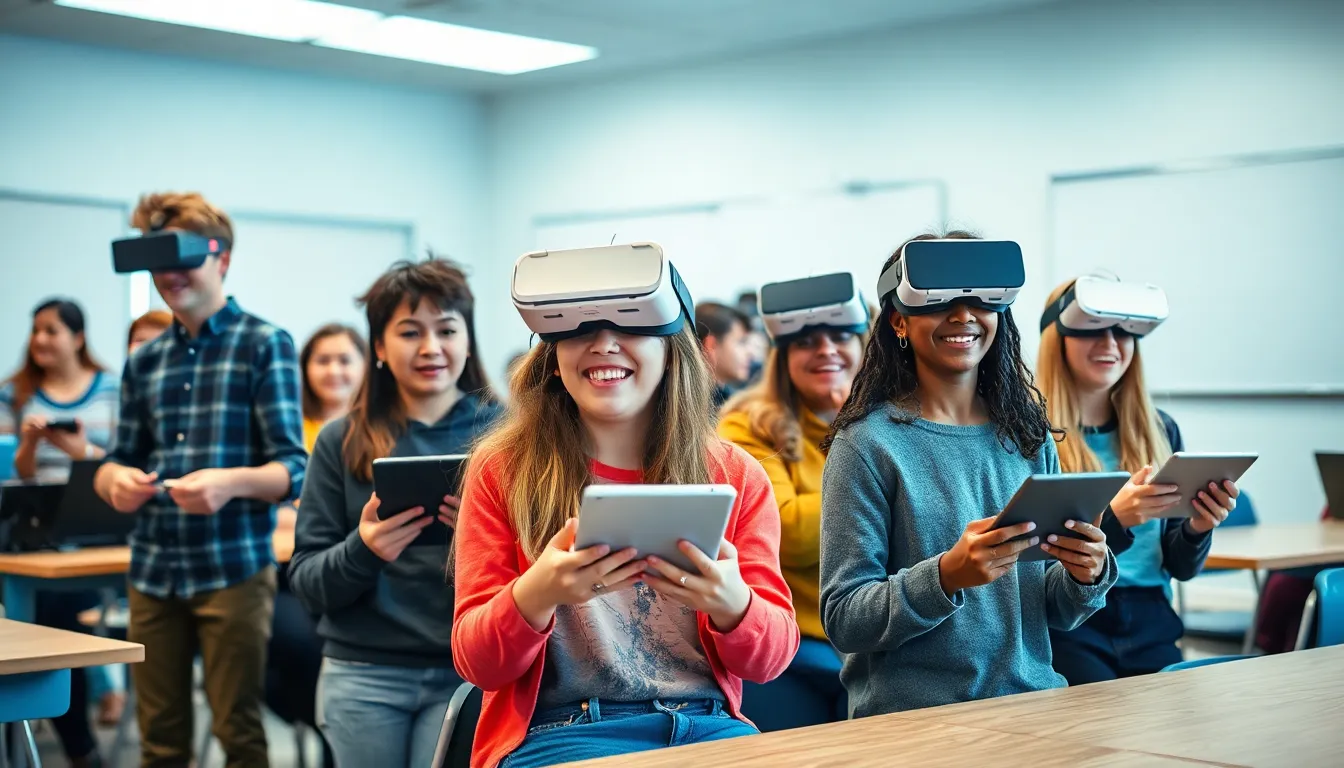Table of Contents
ToggleIn a world where classrooms are morphing into tech playgrounds, EdTech news is the lifeline educators, students, and parents didn’t know they needed. Imagine a place where learning meets innovation, and textbooks are traded for tablets faster than you can say “Wi-Fi.” The latest trends and breakthroughs in educational technology are reshaping how knowledge is shared, making it more accessible and engaging than ever before.
Latest Trends in EdTech News
Educators and learners experience an ongoing evolution in educational technology. Current trends spotlight various advancements shaping the future of learning environments.
Emerging Technologies
Artificial intelligence leads the charge in EdTech innovations. Adaptive learning systems use AI to personalize educational content, catering to individual student needs. Virtual reality creates immersive experiences, allowing students to explore new concepts in engaging ways. Blockchain technology emerges, providing secure and transparent credentialing and assessments. Increased connectivity using the Internet of Things enhances collaboration between devices and users, streamlining the learning process.
Innovations in Learning Platforms
Learning platforms undergo continuous enhancements to support diverse learning styles. Gamification incorporates game mechanics, making learning more interactive and enjoyable. Microlearning platforms deliver content in bite-sized formats, enhancing retention and engagement. Learning Management Systems evolve, integrating analytics to provide real-time feedback on student progress. Mobile learning applications offer convenience, enabling students to study anytime and anywhere, promoting flexibility in education.
Impact of EdTech on Education

EdTech significantly transforms educational experiences, leading to enhanced methods and increased opportunities for both students and educators. Innovations in technology drive engagement and accessibility in learning environments.
Enhancing Student Engagement
EdTech tools captivate student interest by providing interactive content that promotes active participation. Gamification strategies integrate game elements to motivate learners, fostering a sense of achievement. Immersive experiences through virtual reality place students in realistic scenarios, enhancing understanding and retention of information. Personalized learning paths enable tailored experiences, catering to individual student needs. Real-time feedback empowers students to track their progress, encouraging self-directed learning.
Improving Accessibility
EdTech breaks geographical barriers, making educational resources available to learners in remote areas. Online courses offer flexibility, allowing students to study on their terms and schedules. Assistive technologies support individuals with disabilities, ensuring everyone accesses quality education. Mobile applications facilitate learning anytime, anywhere, promoting continuous educational engagement. Additionally, open educational resources provide free access to materials, democratizing learning opportunities across demographics.
Key Players in the EdTech Industry
The EdTech industry features a dynamic landscape filled with innovative startups and well-established companies. Each group significantly contributes to educational technology advancements.
Notable Startups
Startups like Duolingo and Kahoot! redefine learning through engaging platforms. Duolingo offers gamified language learning, catering to millions with its user-friendly approach. Kahoot! focuses on interactive quizzes that promote classroom engagement and competition. Other notable names include Coursera, which connects learners with top universities, and MasterClass, known for its celebrity-led courses that bring real-world expertise into the digital space. Entrepreneurs in this sector prioritize user experience and accessibility, making quality education widely available.
Established Companies
Established companies such as Google and Microsoft maintain a strong presence in the EdTech sector. Google Workspace for Education enhances collaboration and productivity in classrooms through tools like Google Classroom and Google Drive. Microsoft Education provides robust solutions through its Office 365 suite, designed for educators and students. Pearson, a leader in educational publishing, blends traditional content with digital resources to improve learning outcomes. These industry giants invest in research and innovation, ensuring they adapt to the evolving needs of educators and students alike.
Challenges Facing EdTech
EdTech faces several challenges as it evolves and expands in the educational landscape. These challenges impact funding and regulatory compliance, hindering the potential growth and effectiveness of technology in education.
Funding and Investment Issues
Funding remains a significant barrier for many EdTech startups and projects. Investors often hesitate to allocate resources when uncertainty surrounds market viability and profitability. Established companies face pressure to maintain returns, limiting their willingness to back new innovations. Disparities exist in access to funding, with some regions receiving more support than others. These financial constraints can stifle the development of cutting-edge technologies, delaying advancements that could enhance educational experiences. Prioritizing consistent investment in promising online learning initiatives fosters broader access and innovation.
Regulatory and Compliance Hurdles
Compliance with educational regulations presents another challenge in the EdTech sector. Numerous guidelines govern data privacy, accessibility, and content standards, often varying by state or region. Navigating these complex regulatory environments can be daunting for startups and developers. Non-compliance risks severe penalties and damage to reputation. Adjusting products to meet legal requirements takes time and resources, potentially diverting efforts from innovation. Fostering collaboration between EdTech providers and regulatory bodies supports the establishment of clear guidelines that ensure safety and effectiveness in the learning environment while promoting technological advancement.
Conclusion
The landscape of EdTech continues to evolve at a rapid pace. As technology integrates deeper into education, new opportunities arise for enhancing learning experiences. The innovations discussed not only engage students but also empower educators to deliver personalized instruction.
Despite the challenges in funding and regulation, the potential for growth remains significant. Collaboration among stakeholders can pave the way for a more effective and inclusive educational environment. As the industry adapts to changing needs, the future of EdTech looks promising, making quality education accessible to all.







